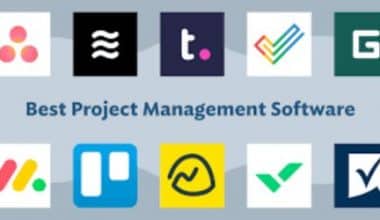A project manager’s primary responsibility is to oversee all stages of a company’s projects and ensure their effective conclusion. They create documentation to inform stakeholders, direct team members, and establish the duration of a project. They can also develop change management plans to accommodate changes in project operations and timetables.
This article defines the change control process, examines why it is important in project management, explains how to implement it, and provides management advice.
What is Change Control In Project Management?
Change control is a process that detects, records, and approves any essential changes that occur in a project in order to avoid unnecessary disruption.
Change efforts at scale, such as digital transformation, necessitate the total cooperation of several organizations and teams, posing additional obstacles for project managers. These types of efforts necessitate strict and systematic control methods.
One of the key functions of change management is to minimize unapproved changes, which helps to reduce errors. Furthermore, project managers can make better use of available resources by adopting a planned and integrated change control process.
The Benefits of the Change Control Process
An efficient change control process in project management can be quite valuable to your company. Companies can boost staff productivity by using a cutting-edge change management process and promoting collaborative teamwork and change communication. Here is a list of the advantages of the change management process.
- Project managers will learn about the need for change during the change planning phase and have time to consider the best course of action.
- Reduce the risk associated with each modification;
- Superior cost-cutting and risk-mitigation capabilities;
- Making adjustments takes less time;
- Changes can be made with less influence on the project schedule because requests will be considered and managed in accordance with the project schedule.
What are the Different Types of Change Control?
Change management is divided into two categories:
- Unexpected changes
- Work changes
Unexpected changes necessitate rapid action. E.g. An unanticipated change is when a product is withdrawn from the market due to an unavoidable difficulty.
Planned modifications, on the other hand, are carried out with thorough preparation, risk analysis, and adherence to a strict timeframe. A planned change has the specific goal of preparing the organization or a specific team within the organization for new goals or objectives. Changes in company culture, internal structure, processes, or any other feature are examples of this.
Key Change Control Process Elements
#1. Change Requests
If you wish to update something about your project, you must submit a change request. This document summarizes the proposed modifications as well as their primary rationale. Change requests can be submitted by anyone involved in a project, whether internally or externally.
#2. Change Control Board
A change control board’s aim is to review and decide on proposed changes to a project at regular intervals. If the change request is authorized, a change order can be generated.
#3. Order Change
If the change control board approves the requested modification, the board and the impacted clients or stakeholders must sign a change order. The terms originally mentioned in the contract will be modified, and both parties consent to these revisions.
#4. Log Change
A changelog is a tool used in change management to maintain track of any changes made to the plan or agreement for a project. A well-defined change log should be accessible to all project managers.
The Change Control Process Steps
A typical change management process flow consists of five steps. Check out the phases in the change management process below to effectively build and implement the proper plan of action.
Step #1: Identifying the need for change
Any stakeholder can make a change by identifying the need for the change and explaining it on a project change request form. A change request form initiated by any team member should include the following information:
- The title of the project
- Date
- Description of the request
- Requested by
- Change the owner
- The Effects of Change
- Deadline
- Priority
- Comments
Step #2. Evaluate the Request for Change
As a project manager, you must decline or cancel any modification requests that are not legitimate.
Then you must determine what resources will be required to do the change request analysis.
Then, immediately assess the probable outcomes and amend the request form as necessary.
Rejected requests for revisions should be put on hold for the time being.
Step #3. Analyze the Change Request
Assign the modification request to a qualified staff member for evaluation.
This analysis should be repeated with the deferred change factored in.
Step #4. Carry out the Change Request
- Determine the risk and complexity of the change before approving it.
- Before final approval, assess the impact of the change.
- Analyze the Impacts of Change and submit a request for review to the appropriate authorities.
Step #5: Close the Change Request
- Practices and procedures for project management should be reviewed.
- It is critical to keep everyone up to date on the developments.
- Check the request for change status on a regular basis.
- Keep a record of the outcome of the change request.
- Stop the change request.
Different Change Control Process Factors
There are six main parts to the various aspects of a project change control process. Leadership Alignment, Communication, Stakeholder Engagement, Change Impact, Readiness, Training, and Organization Design are examples of these.
#1. Leadership Coordination
Leadership Alignment should not be difficult. The project sponsor usually provides the original brief and discusses the benefits, so they should already be on board. Keeping employees enthusiastic and on board with the project, however, might be difficult if they are under a lot of pressure and their priorities are constantly shifting.
Project managers frequently assume that other senior executives involved in the project have the same viewpoints as the project sponsor or agree with the project’s objectives. If they aren’t, it’s critical to enlist their help because your senior team members will have an impact on other stakeholders.
#2. Stakeholders Analysis
It is critical to do a stakeholder analysis at the start of a project. It allows you to locate and learn about project stakeholders, group them, and create engagement plans for each group.
Stakeholder engagement is a critical component of change, and it should be maintained throughout a project and even afterward to make a change stick. Stakeholder groups and plans for involving them should be revised and updated at various stages throughout the project.
#3. Communication
The most critical aspect is communication. A project manager must determine which communication channels are accessible and then take the necessary actions to use them. You want to pique people’s interest in your project. People will make up their own truths if they can’t communicate with one another. So, if you want to say something, say it. Declare whether or not you have any new knowledge.
#4. Change Impact and Readiness
Change Impact and Readiness is a critical aspect of the change management process. It is determined by how much the change affects stakeholders and how prepared they appear to be to make the adjustment. Readiness activities, such as a Readiness Checklist and a Readiness Status Tracking system, provide insights into the group’s ability to implement the change and lowers delivery risks.
As a project manager, you must guarantee that the organizations in charge of implementing the modifications can answer your readiness questions accurately. If they say they’re ready but aren’t, you’ll have trouble with the delivery later on. When projected readiness levels are not met, change plans should be employed to limit project damage.
#5. Training and Adherence to Organizational Structure
Training is required to assist with adoption and integration where knowledge gaps have been identified. This could be both technological and behavioral in nature. The ideal way to train will be one-on-one, in groups, through “train the trainer” programs, training guides, or in a remote or controlled setting, depending on the sort of change and the number of individuals involved.
Businesses or teams affected by the change may need to build new organizational structures or make changes to existing ones in order to accommodate the transition. The “as is” and “to be” analyses should be completed, as well as the associated procedures and job descriptions.
Organization Design may not be part of the project, but it is required for it to function. This means that design work must occur concurrently with the primary project activity, and any adjustments must be made prior to, or even during, the project’s delivery date.
How To Implement Integrated Change Control In Project Management
#1. Create a change management system:
Define what constitutes and does not constitute a change request. For example, adding an extra step to a project phase that will not take too much time and will not interfere with your schedule will not necessitate a modification request, but adding an extra step that will interfere with the deadline will. Determine the process for submitting, approving, and updating requests.
#2. Create change management procedures:
Assign a leader to this process who will communicate with stakeholders, oversee progress, and keep everyone updated. They’ll also respond to modification requests with preset responses to keep the process rolling. Include a breakdown of how the proposed change would influence the budget, timing, risks, stakeholders, consumers, and team members.
#3. Write down the impact of potential changes:
Use a chart to map out the area affected by the change request. Including the money, the timetable, the resources, and the quality. Then, define the modification as well as any preliminary queries you or team members may have about it. After that, compute the impact using KPIs for each region. For example, if the budget is affected, calculate the likely consequence using money that would be lost or gained if the change is accepted.
If you haven’t previously done so, make a list of all the tasks related to the project. Check the modification request against the task list to see if there are any conflicts. You may even discover significant overlap, which would allow you to combine or perhaps eliminate some of your current burdens if the change is implemented.
#4. Draft templates:
By automating your change management process, you will save time communicating each new phase. If more than one person oversees the process, it will also help other team members follow a consistent protocol. Create an intake, processing, approval, and next actions template.
Tools for Change Control Process
Project managers require access to change control tools in order to establish an effective plan for change management. You should search for the following tools in your change control software depending on the nature of your project workflow.
#1. Process Maps / Flowcharts
Flowcharts and process maps are excellent tools for change management mapping. It enables all stakeholders, whether internal or external to the project, to gain a comprehensive understanding of the process.
A flowchart is simple to construct and maintain. A flowchart allows project managers to map out the current state of the organizational process, update the change management cycle, and add or remove change requests based on change control board approval.
#2. The ADKAR Evaluation
The acronym ADAKAR stands for Awareness, Desire, Knowledge, Ability, and Reinforcement. In change management, ADKAR analysis is used as a training technique to guarantee that all project participants believe in and support the change. It denotes a set of objectives for team leaders. The plans are intended to carry out the previously agreed improvements. Product managers can attain these objectives by
- Raising awareness,
- Reviving employees’ willingness to participate,
- Providing necessary knowledge,
- Increasing ability,
- Making the adjustments stick.
#3. Force Fields Analysis
As a project manager, using a barrier and aids analysis or force field analysis can help you make better decisions. It’s a valuable technique for understanding why stakeholders support or oppose a change idea.
#4. Culture Map
A culture map tool is often used to depict how company rules, values, and employee behavior influence company culture. It enables product managers to locate information critical to change initiatives. A culture map can assist you as a project manager in identifying the positive enablers in your team. As a result, it is easier to assign responsibility to the appropriate person, guaranteeing that the project faces the least amount of risk.
Aside from these, project managers can use a variety of other tools to improve change management.
2023 Change Control Process Templates
When it comes to properly executing changes, Change Control Process Templates are quite important. Depending on the nature of the changes, project management teams may employ a variety of change control templates. Let’s have a look at some popular change control templates.
#1. Change Proposal Template
Even if the change has already been accepted, a change proposal template will assist you in determining the “why” behind the change. Once you’ve completed this template, you’ll be able to explain why the change is important and assist others in doing the same.
Important components:
- Changes that have been proposed
- The reason behind the change
- Results to be expected
- Time estimate
- Cost estimates
- Any other considerations
#2. Change Communication Plan Template
A communications strategy is an essential component of any plan. People affected by a change are ultimately responsible for its success, therefore developing a plan for communicating the change is critical. A change communication plan template will aid in the strategy’s execution.
Elements to Consider:
- Change Management Model
- Change Leader
- Communication-related events
- Communication date
- Audience
- Communication method
#3. Change Analysis Form
Each phase in the change management process is comprised of multiple smaller steps. Project managers must thoroughly examine each of these processes. A change analysis template aids in the effective monitoring and implementation of changes.
Elements to Consider:
- Change Management Model
- Analysis date
- Problems encountered
- Successes
- Required steps
Best Practices for the Change Control Process
#1. Use project management software.
Using project management and change control software to ensure that your change control procedures run smoothly is a wonderful method to ensure that your change control processes work successfully.
Software created expressly for project management can provide several benefits, such as improved communication, on-time scheduling, and greater utilization of available resources. Through the use of collaborative software tools, team members can better grasp their roles and the general goals of the team. The following are some examples of software that aids collaborative work:
- Trello
- Project Microsoft
- Freedcamp
- Hive
- Asana
#2. Recognize Potential Hazards
Project management risk can be defined as anything that could prevent the project from attaining its objectives. Project managers routinely examine the project’s possible risks during the change management process. Only then will they be able to develop effective change management strategies that will have the least amount of negative impact on the business.
Risk identification, evaluation, and mitigation are critical components of effective change management. Creating an efficient change management system allows firms to anticipate and easily overcome possible roadblocks.
#3. Make a Change Control Plan.
When adding changes to a project, a well-thought-out change control plan can increase output while decreasing wasted time. This is due to the fact that having a sound management approach can assist a project manager in anticipating problems, creating alternatives, and preparing for any eventualities. With these plans, establishing a big shift in an organization can help with cost-cutting and scheduling while assuring no negative influence on other operational elements.
#4. Make use of a Change Request Form as well as a Change Log.
A standardized request form simplifies the process of tracking, analyzing, and implementing change requests. By providing team members with a consistent framework to follow when requesting a change, Change Control Templates may ensure an effective change control process. It also assists project managers in keeping track of change requests and previous changes.
What is the Distinction Between Change Management and Change Control?
After an organizational transition, change management is a process of analyzing, adjusting, and adapting to new standards. Change control, on the other hand, is a subset of change management that sources, analyzes, manages, and generates a roadmap or change implementation plan.
How Do You Handle Change Management in a Project?
To effectively manage change control in a project, project managers might use a change control template and maintain a careful eye on the change log.
What are the Three Primary Goals of Change Management?
A change management process has three primary goals:
- Analyzing the process and implementing corrective and preventative measures to prevent repeating problems in a project.
- Ensure that all change requests are in accordance with the project management plan.
- Processing change requests in accordance with the direction provided by the authorized authorities.
How Should a Change Control Document Be Written?
Project managers should draft an effective change control process document.
- Explain why the adjustment was made.
- Create a change management team by identifying various stakeholders. Clarify the specific advantages of the modification.
- Set defined targets for the project management team to achieve in order to complete the project.
Conclusion
Change management enhances teamwork, increases employee productivity, and allows teams to address challenges much more quickly. As you read the text, you will get some important knowledge about numerous aspects of the change management process.
Related Articles
- CHANGE MANAGEMENT TOOLS: Techniques & All You Need to Know
- Best 20 Software For Change Management In 2023: Detailed Reviews
- ORGANIZATIONAL CHANGE MANAGEMENT: All You Need To Know
- PROJECT MANAGEMENT: Definition, Software, Skills, Steps & Salary
- CHANGE MANAGEMENT: Steps To The Change Management Processes






